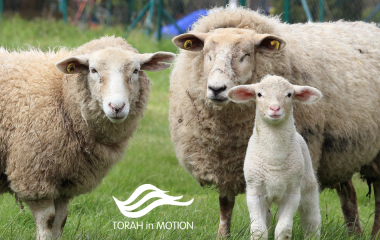
"This is the law of the sin offering, chatat: at the place where the elevation offering, olah, is slaughtered shall the sin offering be slaughtered before G-d, it is holy of holies" (Vayikra 6:18).
The korban chatat and korban olah are polar opposites. The korban olah reflects our total dedication to G-d. No part of the sacrifice is to be consumed by humans. It is, literally, an elevation sacrifice, representing our striving to come closer unto G-d. It is usually brought voluntarily, when one wishes to go beyond the call of duty to reach G-d.
On the other hand, the korban chatat represents distance from G-d. It is brought because—and only because—we have sinned. And here we are dealing with the most major of sins; those sins that carry the consequence of karet, being cut off from the Jewish people and their future. These include eating on Yom Kippur, eating chametz on Pesach, violation of Shabbat, and various types of sexual transgressions. One cannot volunteer to bring a chatat; it is an imposed obligation.
Whereas the olah is a conscious attempt to come closer to G-d, the chatat represents our forgetting G-d. The chatat is brought only when sins are committed "inadvertently", when we were not thinking about our relationship with the Almighty. While a chatat is, in theory, based on a mistake, most mistakes are the result of carelessness. Why, then, does the Torah insist that the chatat must be offered at the same place—the northern part of the altar—as the olah?
Judaism has long recognized that sin is necessary in order to grow closer to G-d. If we do not fall and fail, we cannot rise higher. The Torah does not hide the faults of our great leaders. Avraham, Yaakov or Moshe would not have been quite as great had they not sinned at various points in their life. The yetzer hara, our evil inclination, is a gift from G-d; enabling us, as our rabbis point out, to have children or to engage in commerce. "I created a yetzer hara", G-d declares, and "created the Torah as a spice, tavlin, to it" (Kiddushin 30b). We must channel the yetzer hara to positive purpose, but we need it working hard within us. It is not to be eradicated, only spiced up, so that it has a good taste. In fact, the greater the yetzer hara and the greater the sin, the greater the potential for growth, for more mitzvoth. It is not by chance that our rabbis assert the birth of the mashiach began on Tisha B'av; only when one hits rock bottom can one begin the climb to the top.
While sin itself is evil, sinners are not. A sinner can transform a sin into a mitzvah. Perhaps this helps to explain the ambivalent attitude we sometimes have towards those who have yet to make this transformation. Yet, when one accepts sin as normal and proper, without using it as an impetus to grow, sin can become contagious and spread within us and beyond. We run the risk that those exposed to sin without protection may, too, become sick.
Without welcoming sinners into our midst, there is no way they can begin the process of spiritual growth. Thus, on the two holiest nights of the year, we invite all—including the greatest of sinners—to join us. We begin Yom Kippur with a pronouncement that we "allow" ourselves to pray with the sinners. On Pesach night we invite the rasha, the evil one who "removes himself from the community", to join with his brothers and sisters as we appreciate our past, enjoy the present and look forward to a glorious future.
The korban olah and korban chatat must be offered from the same place. Often, it is only after bringing a chatat that we can hope to achieve an olah. The transformation of a chatat into an olah brings us even closer to G-d. Both those who bring a sin offering and those offering an olah must continually nurture and evolve their relationship with G-d. It is the merging of the chatat and the olah that allows us to "enter" the holy of holies. It is for good reason the korban olah and the korban chatat must be offered from the same place.



